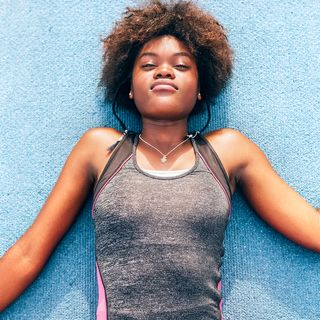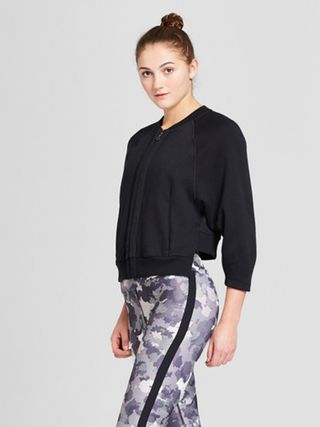Confession: I Was a Body-Positivity Advocate Who Secretly Hated Her Own Body
Experts estimate that about 8 million people in the U.S. are currently suffering from an eating disorder—and that's not even to mention the long, arduous process of recovery nor the rampant misunderstanding of these issues in our culture. As a nod to Eating Disorder Awareness Week (February 26 to March 4), we'll be featuring some of our most thought-provoking content on body image, diet talk, and the stigma and shame that millions of women deal with on a daily basis. Above all else, know that you're not alone—and if you need help and don't know where to begin, reach out to the National Eating Disorders Association hotline at (800) 931-2237.

Things most frequently heard when working at a specialty running store: “You look like a runner—how much do you do a week?” and “I’m not a real runner, I just… ” In the eight years I spent on and off as a staffer at a shop that specialized in fitting people for the right shoes and helping them get moving in whatever way worked best for them, I lost track of how many times I heard those comments. The answers I provided, especially toward the end of my time there, were always “I run to the fridge and back” and “Do you run? Walk? Move? Are you happy with what you can do? Then you’re a ‘real’ runner, athlete, etc.”
It was my favorite part of the job—breaking down the idea that there is one type of athletic body type (or even that there had to be an “athletic” side to everyone—sometimes people just wanted their feet to be comfortable in their daily lives and weren’t looking for a change or an epiphany), speaking with children about what a “runner” looks like, and helping people of all activity levels start moving in the ways they want to.
The ethos of the store itself had been that everyone could be an athlete and that there was no shame in embracing where you were at the moment. I loved that, but I always felt like a fraud because how can you work in the world of endurance sports and try to teach others to love their bodies for what they can do when you hate the sight of your own? Even as I was telling people that bodies are built to be strong in their own ways, I couldn’t stand looking at my own body in the mirror.
Though I no longer work at the running store and am no longer surrounded by people aiming to cut time from their runs, PR every race, and build their best, strongest selves, I still feel the same: Every time I breathe or move I can feel the bits that are too much—the ones that I haven’t been able to get “under control” yet. Some days, my body feels like it’s too much mass to move, while others it feels like it takes up too much space. It feels like a weight. It feels sluggish and slow. It feels like something I need to be ashamed of. It feels like something I’m never going to feel in control of.
The fact that I attempt to control what my body looks like and what it is physically capable of to cope with not controlling more than a thousand other things in life is something that I struggled to come to terms with while trying to encourage other people to accept themselves. In other words, the joy I felt doing that job and bringing a sense of positivity to others did not outweigh the negativity I felt and still feel toward myself.
The act of projecting a healthy life (or so-called body positivity) and constant improvement can feel like an assault.
I didn’t always feel this way. I grew up swimming every weekend, biking with my family in the local state park, playing soccer, horseback riding, rock climbing, hiking, and being generally active. I liked learning how to do things—learning to be active in different ways was like reading different genres with my body. I wasn’t really ever a competitive sports person—though always on teams, I ran for myself because it felt good and it made me strong. I was also a competitive ballroom dancer in college, and that was the only time I wanted to push myself to compete with others and not just perfect a skill.
When I was still dancing, I was confident in my movements and with my presence. I felt in control. I had no problem running around a city in my Latin ballroom costumes without hesitation or shame. When I was running daily, I had no problem being in just cropped tights and a sports bra on hot days. But now? Now I buy clothing I can hide in because I feel larger than I logically know I am. I hate having my skin show. I know by how many inches I would tone up my body in every single spot. I know how weak I feel in comparison to how much physical strength I used to have. I might talk the talk of empowering other people, but I don’t feel strong. I don’t feel empowered. I feel uncomfortable.
At the same time, given how society views wellness and the image of “health,” I also know I don’t look like I should feel this way. And it is something we don’t think about or talk about—how deeply personal body image is. Not only that, but in many cases, “body positivity” has become aligned not with actual acceptance of one’s self as they are but with the #fitspo community and the push to obtain a certain body type to satisfy others’ descriptions of health and wellness. It no longer protects people, but it has become another tool to project the image of perfection.
Sometimes, in a society so obsessed with comparisons, a mutual validation complex, and an almost evangelical approach to working out and being “fit,” we don’t realize that it is impossible to know how anyone else feels about themselves and it is how they feel in their own skin that matters most. British Olympic swimmer Rebecca Adlington called attention to the pressure to project a certain body image placed on female athletes while on the British reality show I’m a Celebrity… Get Me Out of Here. Network BT Sport sent out a body image survey to 110 elite female athletes, with 80% responding that they felt pressure to conform to certain looks and body types and 97% blaming it on a wider problem in society, not just in women’s sports. And while many national teams, college athletic boards, Olympic committees, the NCAA, and the IOC have started to address the prevalence of eating disorders and the effects of negative body image in athletics, especially for women, we are still not having a conversation about how this rolls out into society at large. We still aren’t talking about how we project our thoughts about how other people look and therefore how they should feel about themselves.
The act of projecting a healthy life (or so-called body positivity) and constant improvement can feel like an assault, both against those who don’t want to change themselves because they are genuinely happy with themselves (which is something I would like to eventually strive for) and people who find themselves where I sit right now. We know we are technically fine, but we’ve internalized feeling like we’re somehow not enough because we’re not able to strive in the same ways that we used to athletically. In some ways, we feel like it was the way we looked that gave us value to others. We ask ourselves questions like: Why don’t I like myself if I know nothing is truly wrong with me? Is it because I know I’m supposed to be better, that I was better, or that I should want to be better?
While many national teams, college athletic boards, Olympic committees, the NCAA, and the IOC have started to address the prevalence of eating disorders and the effects of negative body image in athletics, especially for women, we are still not having a conversation about how this rolls out into society at large.
I honestly don’t know when the balance tipped from a sense of knowing there was room for improvement but genuinely being happy with myself and only being able to see imperfections. But I do know that it got worse when I had to stop running and (in a way) give up a part of my identity as an “athletic” human being. About one year ago, I tweaked an old injury and had to give up the things that made me feel fit and strong, and move to yoga and light barre work and started trying to live all the things I was telling everyone who walked into my shop. I was angry and frustrated with a body that just wouldn’t do what I wanted it to do, at a body that refused to heal fast enough and become strong enough.
In this process of trying to find a shortcut, I stumbled upon something called soma yoga, sometimes called somatics or kinetic relaxation. It forced me to slow down and pay attention to my body and how it moved and felt, and it helped me work through that awareness instead of my default revulsion and need to find a way to fix it, whatever “it” was. I got back some of the lightness of movement I felt while I was dancing. I was forced to look at myself harder and become more appreciative of what I could do rather than what I could not. It lifted some of the weight from my mind, if not from my frame. For better or worse, it made me face the fact that my body is mine—I will get no other. It will do what it will do, and I can change that gradually, but I will no longer be able to force it to do what I want by sheer willpower. It will take time and slow growth and there is no guarantee that I will ever have the sense of control over it that I once had.
Someone said you can never go back, and for me, that much is true when it comes down to my relationship with myself and with my body. I don’t work at the running store anymore, I moved to a new country, and I started a different branch of my life. I can’t hide behind hours of dance practice or 90-mile weeks or lie to myself that this is just a snapshot of a longer process of transformation or transition to a body my mind will find more acceptable. I’ve had to look hard at myself and not project a sense that everything is fine or will be fine with time. I don’t like my body or how it feels to inhabit it, and this is where I am now. And that has to be okay, regardless of what anyone else thinks about what I look like or how I should feel because of that.
This story was originally published at a former date and has since been updated.

Here at Byrdie, we know that beauty is way more than braid tutorials and mascara reviews. Beauty is identity. Our hair, our facial features, and our bodies: They can reflect culture, sexuality, race, and even politics. We needed somewhere on Byrdie to talk about this stuff, so welcome to The Flipside (as in the flipside of beauty, of course!), a dedicated place for unique, personal, and unexpected stories that challenge our society’s definition of “beauty.” Here you’ll find cool interviews with LGBTQ+ celebrities, vulnerable essays about beauty standards and cultural identity, feminist meditations on everything from thigh brows to eyebrows, and more. The ideas our writers are exploring here are new, so we’d love for you, our savvy readers, to participate in the conversation too. Be sure to comment your thoughts (and share them on social media with the hashtag #TheFlipsideOfBeauty). Because here on The Flipside everybody gets to be heard.
Next up: How mothers can affect their daughters’ body image.
Disclaimer
This article is provided for informational purposes only and is not intended to be used in the place of advice of your physician or other medical professionals. You should always consult with your doctor or healthcare provider first with any health-related questions.


